Dependence of Conjugate Heat Transfer in Ribbed Channel on Thermal Conductivity of Channel Wall: An LES Study
Abstract
:1. Introduction
2. Numerical Methods
3. Results and Discussion
3.1. Code Validation Study
3.2. Time-Averaged Thermal Fields and Heat Transfer
3.3. Turbulent Heat Transfer
3.4. Instantaneous Thermal Fields
3.5. Thermal Performance and Biot Number
4. Conclusions
- When the thermal conductivity ratio was large (K* ≥ 100), the heat transfer characteristics were similar to those in isothermal conditions. In this case, the impingement of the cold core fluid into the rib and recirculation of the flow mainly affected the convective heat transfer. The heat flux from the solid wall was concentrated on the rib and directed toward both edges of the rib.
- When the thermal resistance of the solid increased (K* ≤ 10), the effect of cold core fluid impingement on the rib decreased, and the two vortices located at the corners played an important role in heat transfer. In this case, the temperature distribution of the solid wall that was affected by the two corner vortices determined the convective heat transfer. In particular, on the downstream face of the rib, a region with negative heat transfer appeared.
- For K* ≤ 10, the turbulent heat flux on the front face of the rib was concentrated at a corner, and the turbulent heat flux whose peak occurred near the channel wall disappeared.
- At K* = 100, the temperature fluctuation at the upstream edge of the rib reached 2%, and at K* = 1, the temperature fluctuation in the solid region was at a level similar to that in the fluid region.
- Below K* = 100, heat transfer enhancement was significantly reduced by conduction. Up to K* = 100, the rib promoted heat transfer, but below K* = 10, it did not promote heat transfer.
- Compared with the thermal resistance of the solid and fluid for the CHT of the ribbed channel, the Biot number that was defined on the basis of the thickness of the channel wall appropriately represented the heat transfer characteristics. In other words, for K* = 100 or higher, the Biot number at the channel wall was considerably smaller than 0.1, but at K* = 1, it was considerably larger than 1, which was consistent with the thermal performance of the rib.
Author Contributions
Funding
Institutional Review Board Statement
Informed Consent Statement
Data Availability Statement
Conflicts of Interest
Nomenclature
| Ac,b | cross-sectional area at the base [m2] |
| Arib | rib surface area [m2] |
| Bi | Biot number (=hd/ks) |
| C* | heat capacity ratio (=(ρ cp)f/(ρ cp)s) |
| d | thickness of the channel wall [m] |
| Dh | hydraulic diameter of the channel [m] |
| e | rib height [m] |
| f | friction factor |
| fi | momentum forcing |
| h | heat transfer coefficient [W/m2K] |
| H | channel height [m] |
| kf | thermal conductivity of the fluid [W/mK] |
| ks | thermal conductivity of the solid [W/mK] |
| K* | thermal conductivity ratio (=ks/kf) |
| ms | mass source/sink |
| Nu | Nusselt number (=hDh/kf) |
| p | rib-to-rib pitch [m] |
| Pr | Prandtl number (=v/α) |
| Q″ | heat flux {W/m2} |
| q | heat transfer rate [W] |
| qf | heat transfer rate through a fin [W] |
| Re | bulk Reynolds number (=UbDh/v) |
| t | time [sec] |
| T | temperature [K] |
| Tb | bulk temperature [K] |
| Tw | wall temperature [K] |
| Ub | bulk velocity [m/s] |
| V′ | wall-normal velocity fluctuation [m/s] |
| W | channel width [m] |
| Greek symbols | |
| α | thermal diffusivity [m2/s] |
| β | mean pressure gradient [Pa/m] |
| γ | mean temperature gradient [K/m] |
| εϕ | fin effectiveness |
| ηϕ | fin efficiency |
| v | kinematic viscosity [m2/s] |
| θ | dimensionless temperature (=(T–Tb)/(Tw–Tb)) |
| Θ | time-averaged dimensionless temperature |
| ω | index function between the solid and the fluid |
| Subscripts | |
| rms | root-mean-square value |
| 0 | fully developed value in a smooth pipe |
| Abbreviations | |
| IBM | immersed boundary method |
| LES | large eddy simulation |
| RANS | Reynolds averaged Navier–Stokes simulation |
References
- Srinivasan, V.; Simon, T.W.; Goldstein, R.J. Synopsis. In Heat Transfer in Gas Turbine Systems; The New York Academy of Science: New York, NY, USA, 2001; pp. 1–10. [Google Scholar]
- Han, J.C. Fundamental Gas Turbine Heat Transfer. ASME J. Therm. Sci. Eng. Appl. 2013, 5, 021007. [Google Scholar] [CrossRef]
- Han, J.C.; Park, J.S. Developing Heat Transfer in Rectangular Channels with Rib Turbulators. Int. J. Heat Mass Transf. 1988, 31, 183–195. [Google Scholar] [CrossRef]
- Park, J.S.; Han, J.C.; Huang, S.; Ou, S.; Boyle, R.J. Heat Transfer Performance Comparisons of Five Different Rectangular Channels with Parallel Angled Ribs. Int. J. Heat Mass Transf. 1992, 35, 2891–2903. [Google Scholar] [CrossRef]
- Ruck, S.; Arbeiter, F. Detached Eddy Simulation of Turbulent Flow and Heat Transfer in Cooling Channels Roughened by Variously Shaped Ribs on One Wall. Int. J. Heat Mass Transf. 2018, 118, 388–401. [Google Scholar] [CrossRef]
- Liou, T.M.; Hwang, J.J. Effect of Ridge Shapes on Turbulent Heat Transfer and Friction in a Rectangular Channel. Int. J. Heat Mass Transf. 1993, 36, 931–940. [Google Scholar] [CrossRef]
- Han, J.C.; Huh, M. Recent Studies in Turbine Blade Internal Cooling. Heat Transf. Res. 2010, 41, 803–828. [Google Scholar]
- Kim, H.M.; Kim, K.Y. Design Optimization of Rib-Roughened Channel to Enhance Turbulent Heat Transfer. Int. J. Heat Mass Transf. 2004, 47, 5159–5168. [Google Scholar] [CrossRef]
- Taslim, M.E.; Wadsworth, C.M. An Experimental Investigation of the Rib Surface-Averaged Heat Transfer Coefficient in a Rib-Roughened Square Passage. ASME J. Turbomach. 1997, 119, 381–389. [Google Scholar] [CrossRef]
- Coletti, F.; Scialanga, M.; Arts, T. Experimental Investigation of Conjugate Heat Transfer in a Rib-Roughened Trailing Edge Channel with Corssing Jets. ASME J. Turbomach. 2012, 134, 041016. [Google Scholar] [CrossRef]
- Ju, Y.; Feng, Y.; Zhang, C. Conjugate Heat Transfer Simulation and Entropy Generation Analysis of Gas Turbine Blades. ASME J. Eng. Gas Turbine Power 2021, 143, 081012. [Google Scholar] [CrossRef]
- Yusefi, A.; Nejat, A.; Sabour, H. Ribbed Channel Heat Transfer Enhancement of an Internally Cooled Turbine Vane Using Cooling Conjugate Heat Transfer Simulation. Therm. Sci. Eng. Progress 2020, 19, 100641. [Google Scholar] [CrossRef]
- Iaccarino, G.; Ooi, A.; Durbin, P.A.; Behnia, M. Conjugate Heat Transfer Predictions in Two-dimensional Ribbed Passages. Int. J. Heat Fluid Flow 2002, 23, 340–345. [Google Scholar] [CrossRef]
- Cukurel, B.; Arts, T.; Selcan, C. Conjugate Heat Transfer Characterization in Cooling Channels. J. Therm. Sci. 2012, 21, 286–294. [Google Scholar] [CrossRef]
- Cukurel, B.; Arts, T. Local Heat Transfer Dependency on Thermal Boundary Condition in Ribbed Cooling Channel Geometries. ASME J. Heat Transf. 2013, 135, 101001. [Google Scholar] [CrossRef]
- Ooi, A.; Iaccarino, G.; Durbin, P.A.; Behnia, M. Reynolds Averaged Simulation of Flow and Heat Transfer in Ribbed Ducts. Int. J. Heat Fluid Flow 2002, 23, 750–757. [Google Scholar] [CrossRef]
- Duchaine, F.; Gicquel, L.; Grosnickel, T.; Koupper, C. Large-Eddy Simulation of the Flow Developing in Static and Rotating Ribbed Channels. ASME J. Turbomach. 2020, 142, 041003. [Google Scholar] [CrossRef]
- Ahn, J.; Choi, H.; Lee, J.S. Large Eddy Simulation of Flow and Heat Transfer in a Channel Roughened by Square or Semicircle Ribs. ASME J. Turbomach. 2005, 127, 263–269. [Google Scholar] [CrossRef]
- Ahn, J.; Choi, H.; Lee, J.S. Large Eddy Simulation of Flow and Heat Transfer in a Rotating Ribbed Channel. Int. J. Heat Mass Transf. 2007, 50, 4937–4947. [Google Scholar] [CrossRef]
- Scholl, S.; Verstraete, T.; Duchaine, F.; Gicquel, L. Influence of the Thermal Boundary Conditions on the Heat Transfer of a Rib-Roughened Cooling Channel Using LES. J. Power Energy 2015, 229, 498–507. [Google Scholar] [CrossRef]
- Scholl, S.; Verstraete, T.; Duchaine, F.; Gicquel, L. Conjugate Heat Transfer of a Rib-Roughened Internal Turbine Blade Cooling Channel Using Large Eddy Simulation. Int. J. Heat Fluid Flow 2016, 61, 650–664. [Google Scholar] [CrossRef]
- Fedrizzi, R.; Arts, T. Determination of the Conjugate Heat Transfer Performance of a Turbine Blade Cooling Channel. Quant. InfraRed Thermogr. J. 2004, 1, 71–88. [Google Scholar] [CrossRef]
- Patil, S.; Tafti, D.K. Large-Eddy Simulation with Zonal Near Wall Treatment of Flow and Heat Transfer in a Ribbed Duct for the Internal Cooling of Turbine Blades. ASME J. Turbomach. 2013, 135, 031006. [Google Scholar] [CrossRef]
- Oh, T.K.; Tafti, D.K.; Nagendra, K. Fully Coupled Large Eddy Simulation-Conjugate Heat Transfer Analysis of a Ribbed Cooling Passage Using the Immersed Boundary Method. ASME J. Turbomach. 2021, 143, 041012. [Google Scholar] [CrossRef]
- Halila, E.E.; Lenahan, D.T.; Thomas, T.T. High Pressure Turbine Test Hardware Detailed Design Report; NASA CR-167955; NASA: Washington, DC, USA, 1982; pp. 18–68.
- Romeyn, A. High Pressure Turbine Blade Fracture CFM56-3C1 Engine Test Cell, 7 July 2004; ATSB Transport Safety Investigation Report; Australian Transport Safety Bureau: Canberra, Australia, 2006; pp. 7–8.
- Ahn, J.; Song, J.C.; Lee, J.S. Fully Coupled Large Eddy Simulation of Conjugate Heat Transfer in a Ribbed Channel with a 0.1 Blockage Ratio. Energies 2021, 14, 2096. [Google Scholar] [CrossRef]
- Neuberger, H.; Hernandez, F.; Ruck, S.; Arbeiter, F.; Bonk, S.; Rieth, M.; Stratil, L.; Muller, O.; Volker, K.-U. Advances in Additive Manufacturing of Fusion Materials. Fusion Eng. Des. 2021, 167, 112309. [Google Scholar] [CrossRef]
- Bang, M.; Kim, S.; Park, H.S.; Kim, T.; Rhee, D.-H.; Cho, H.H. Impingement/Effusion Cooling with a Hollow Cylinder Structure for Additive Manufacturing: Effect of Channel Gap Height. Int. J. Heat Mass Transf. 2021, 175, 121420. [Google Scholar] [CrossRef]
- Ditaranto, M.; Heggset, T.; Berstad, D. Concept of Hydrogen Fired Gas Turbine Cycle with Exhaust Gas Recirculation: Assessment of Process Performance. Energy 2020, 192, 116646. [Google Scholar] [CrossRef]
- Choi, H.; Moin, P. Effects of the Computational Time Step on Numerical Solutions on Turbulent Flow. J. Comp. Phys. 1994, 113, 1–4. [Google Scholar] [CrossRef]
- Kim, J.; Kim, D.; Choi, H. An Immersed Boundary Finite Volume Method for Simulations of Flow in Complex Geometries. J. Comp. Phys. 2001, 171, 132–150. [Google Scholar] [CrossRef]
- Kim, J.; Choi, H. An Immersed Boundary Finite Volume Method for Simulation of Heat Transfer in Complex Geometries. KSME Int. J. 2004, 18, 1026–1035. [Google Scholar] [CrossRef]
- Song, J.C.; Ahn, J.; Lee, J.S. An Immersed-Boundary Method for Conjugate Heat Transfer Analysis. J. Mech. Sci. Technol. 2017, 31, 2287–2294. [Google Scholar] [CrossRef]
- Tafti, D.K. Evaluating the Role of Subgrid Stress Modeling in a Ribbed Duct for the Internal Cooling of Turbine Blades. Int. J. Heat Fluid Flow 2005, 26, 92–104. [Google Scholar] [CrossRef]
- Patankar, S.V.; Liu, C.H.; Sparrow, E.M. Fully Developed Flow and Heat Transfer in Ducts Having Streamwise-Periodic Variations of Cross-Sectional Area. ASME J. Heat Transf. 1977, 99, 180–186. [Google Scholar] [CrossRef]
- Germano, M.; Piomelli, P.; Moin, P.; Cabot, W.H. A Dynamic Sub-grid Scale Eddy Viscosity Model. Phys. Fluids 1991, A3, 1760–1765. [Google Scholar] [CrossRef] [Green Version]
- Lilly, D.K. A Proposed Modification of the Germano Sub-grid Scale Closure Model. Phys. Fluids 1992, A4, 633–635. [Google Scholar] [CrossRef]
- Kong, H.; Choi, H.; Lee, J.S. Dissimilarity Between the Velocity and Temperature Fields in a Perturbed Turbulent Thermal Boundary Layer. Phys. Fluids 2001, 13, 1466–1479. [Google Scholar] [CrossRef]
- Casarsa, L.; Arts, T. Experimental Investigation of the Aerothermal Performance of a High Blockage Rib-Roughened Cooling Channel. ASME J. Turbomach. 2005, 127, 580–588. [Google Scholar] [CrossRef]
- Incropera, F.P.; Dewitt, D.P.; Bergman, T.L.; Lavine, A.S. Principles of Heat and Mass Transfer, 1st ed.; Wiley: Hoboken, NJ, USA, 2017; pp. 153–158. [Google Scholar]
- Ramachandran, S.G.; Shih, T.I.-P. Biot Number Analogy for Design of Experiments in Turbine Cooling. ASME J. Turbomach. 2015, 137, 061002. [Google Scholar] [CrossRef] [Green Version]
- Jung, E.Y.; Chung, H.; Choi, S.M.; Woo, T.K.; Cho, H.H. Conjugate Heat Transfer on Full-coverage Film Cooling with Array Jet Impingement with Various Biot numbers. Exp. Therm. Fluid Sci. 2017, 83, 1–8. [Google Scholar] [CrossRef]
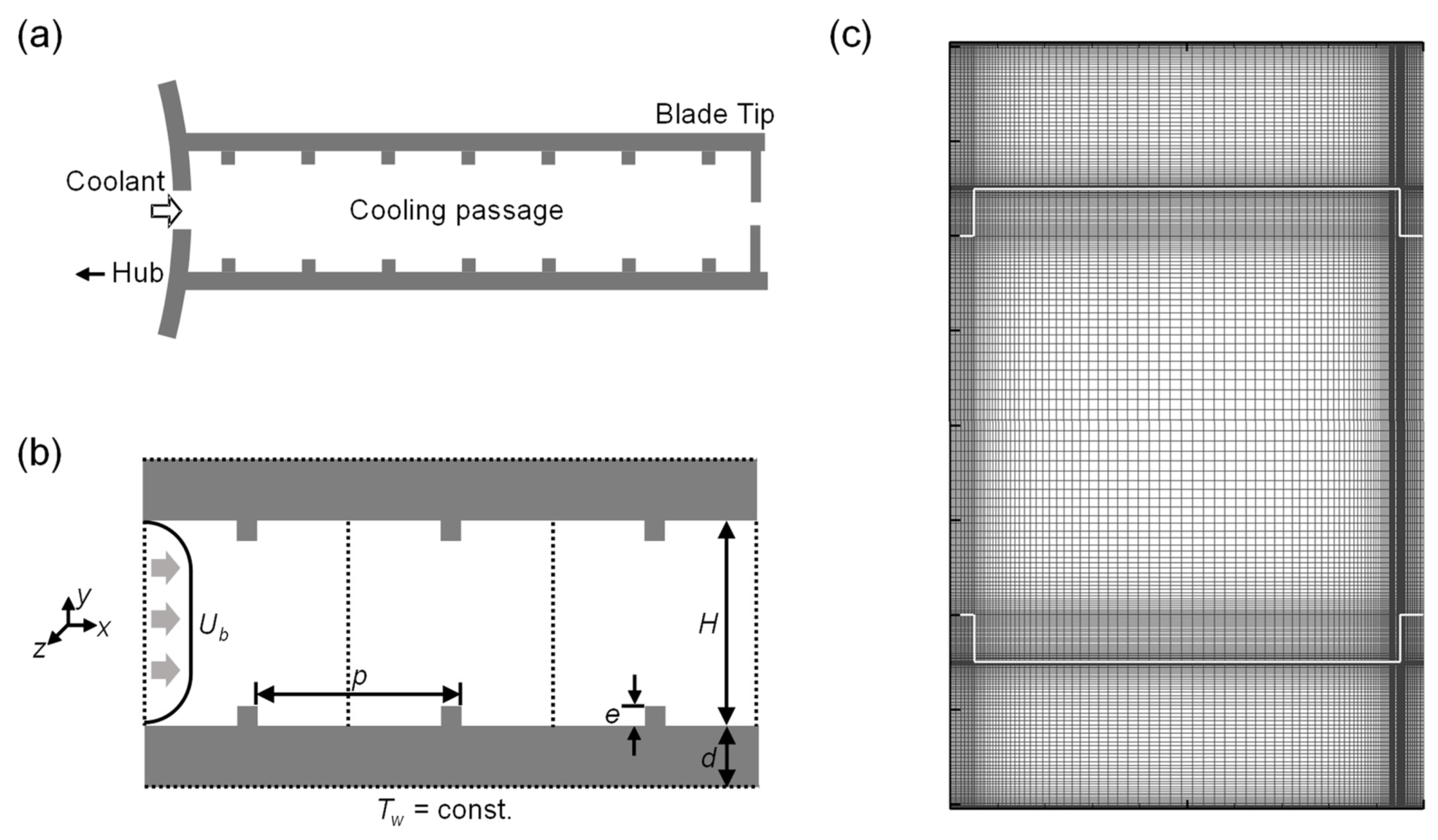
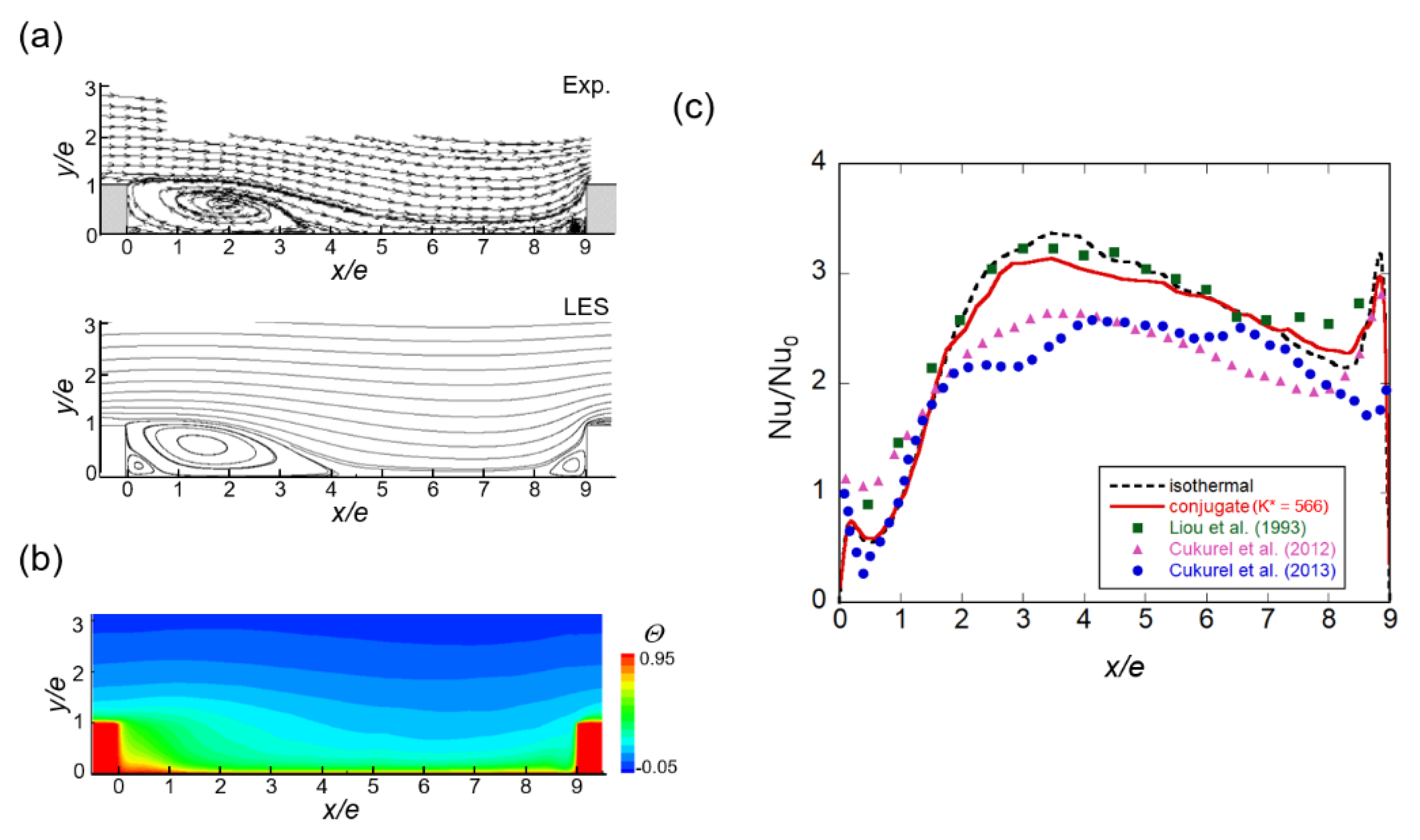
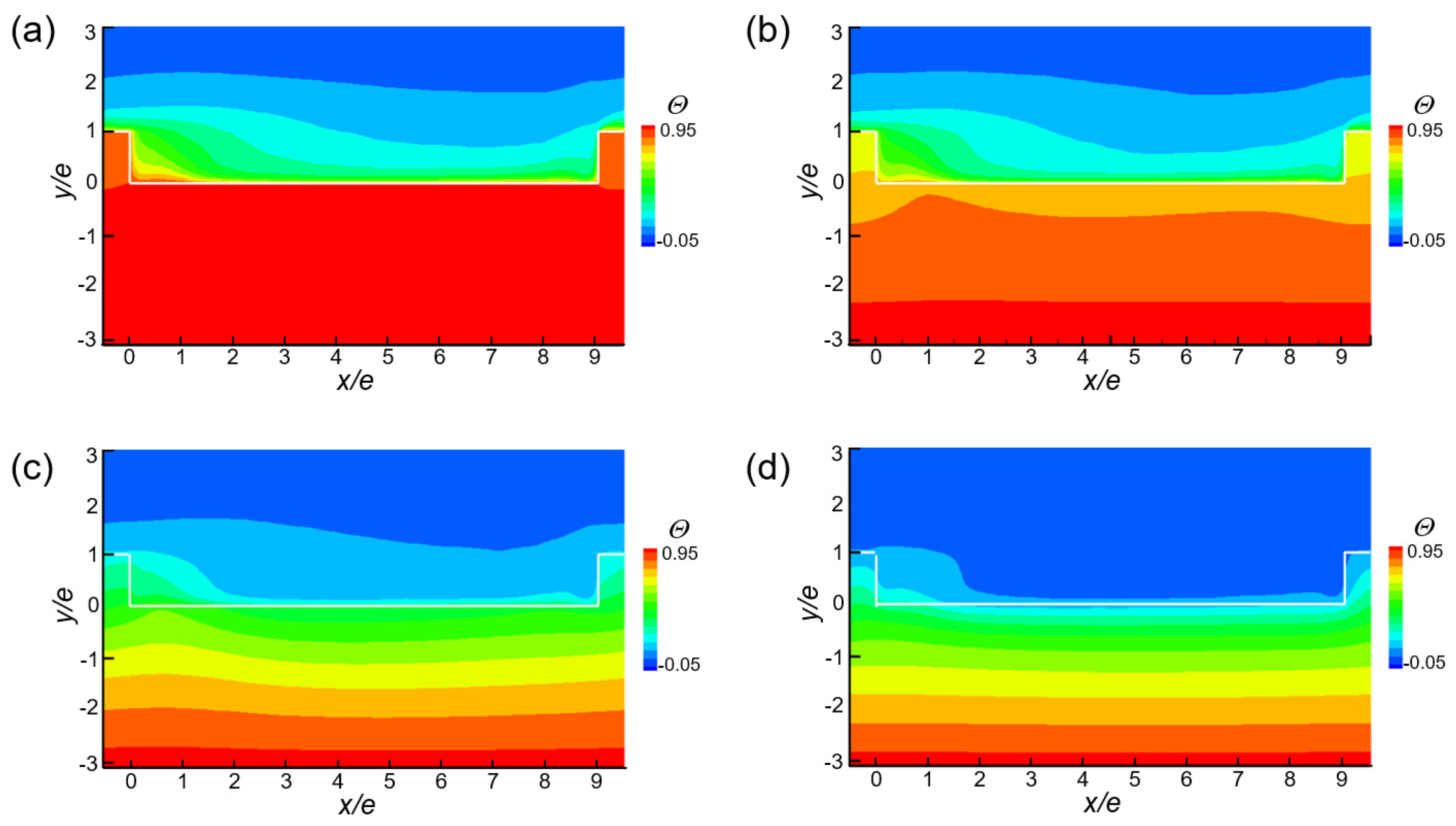
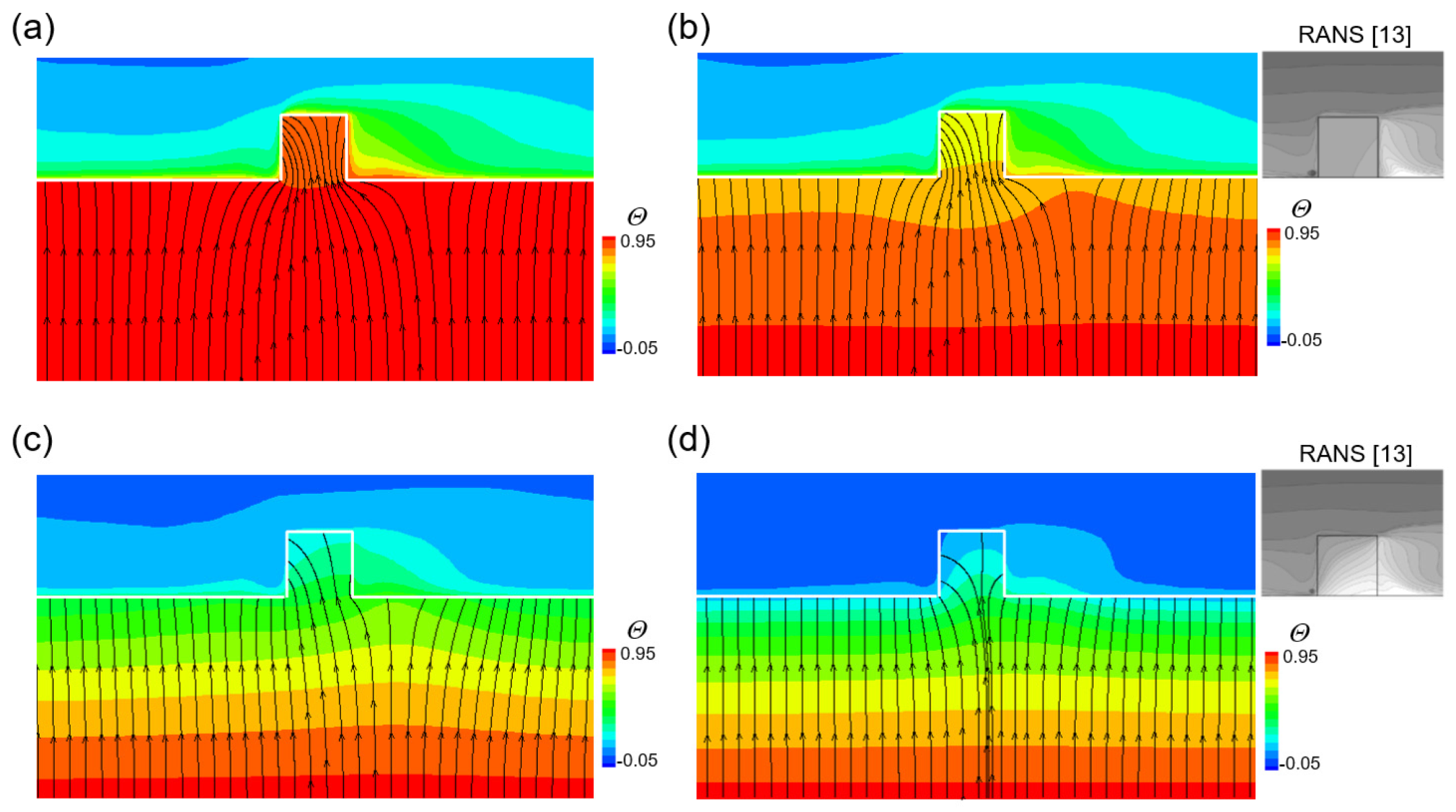
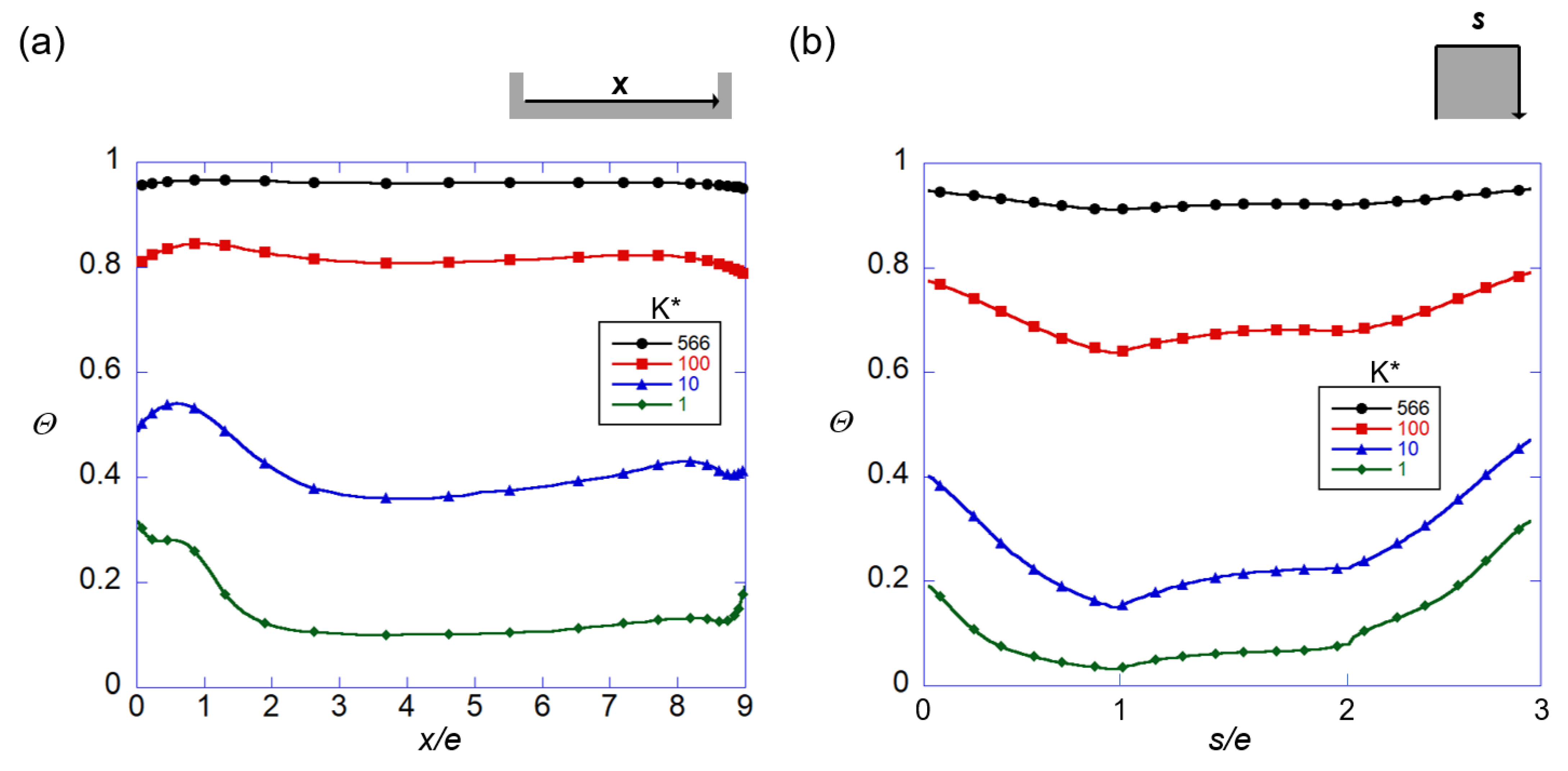
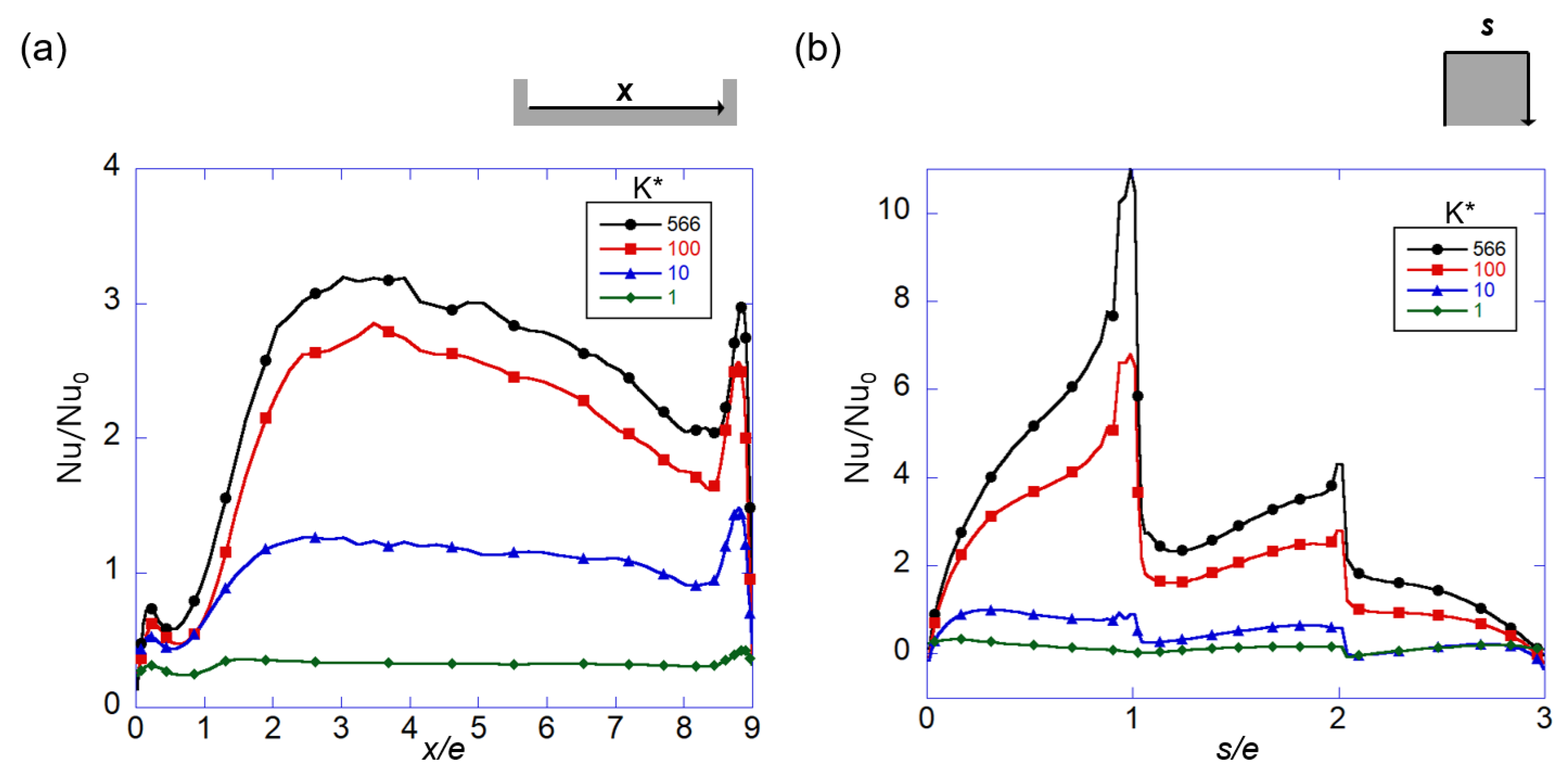
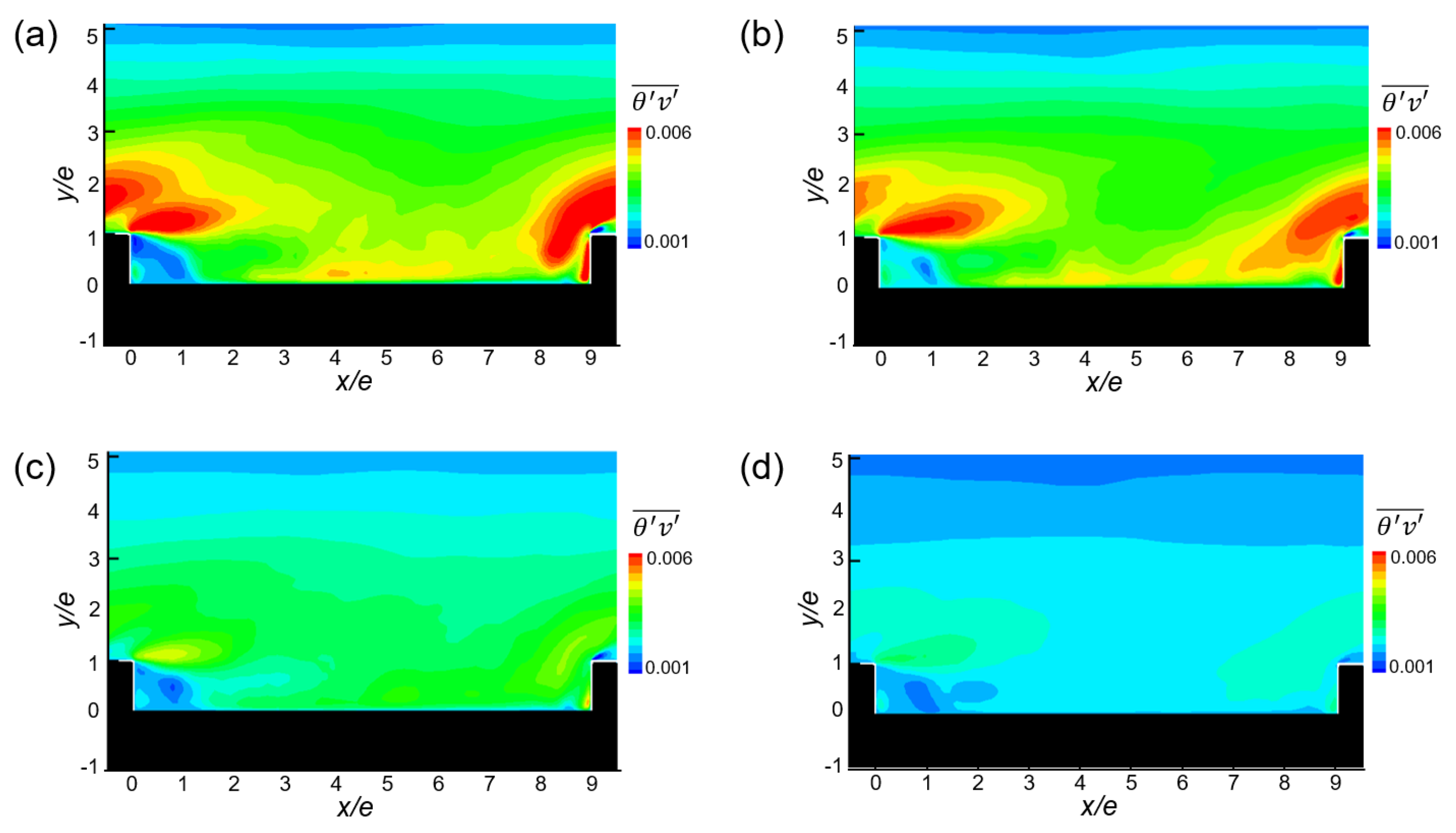
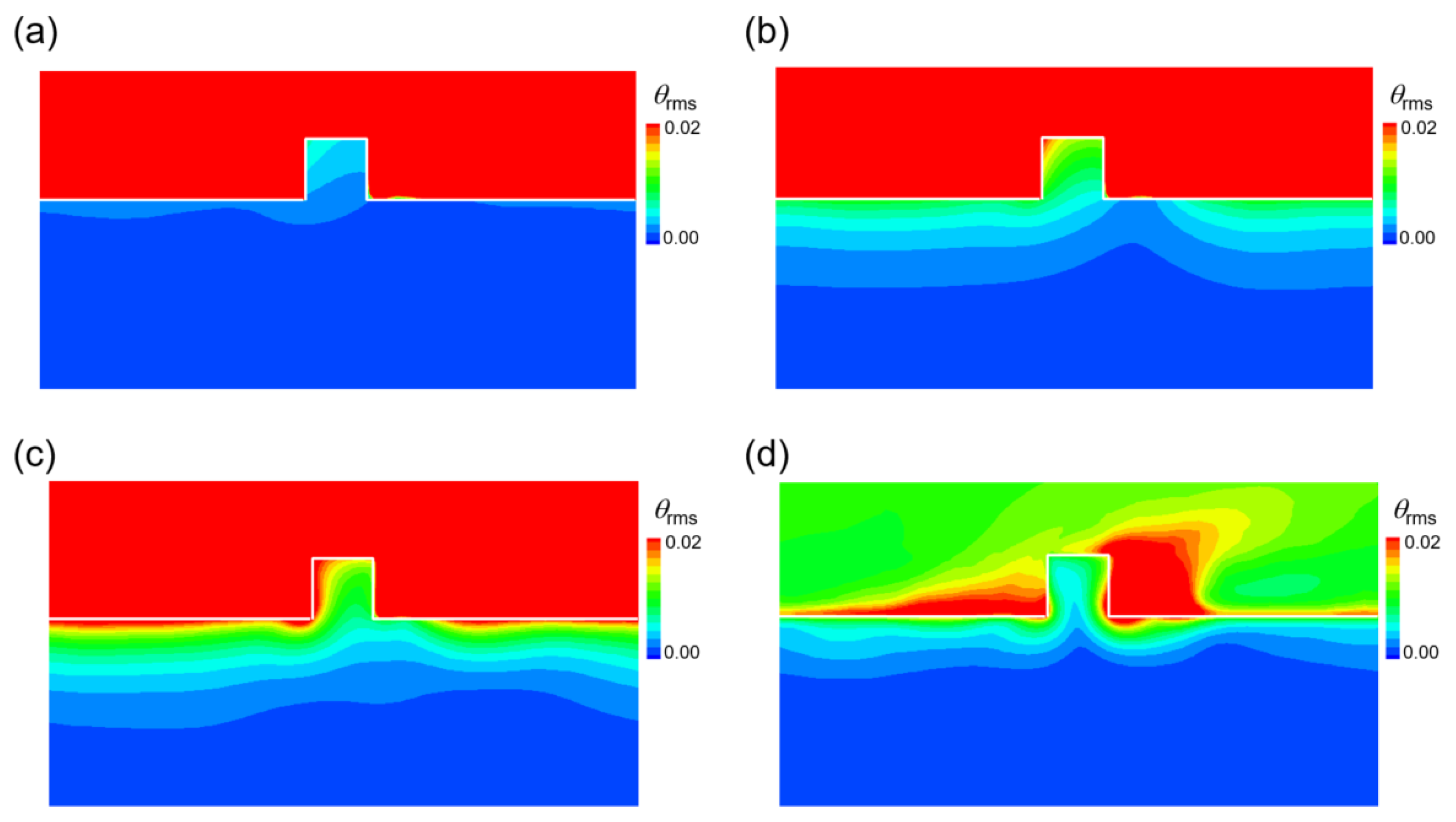
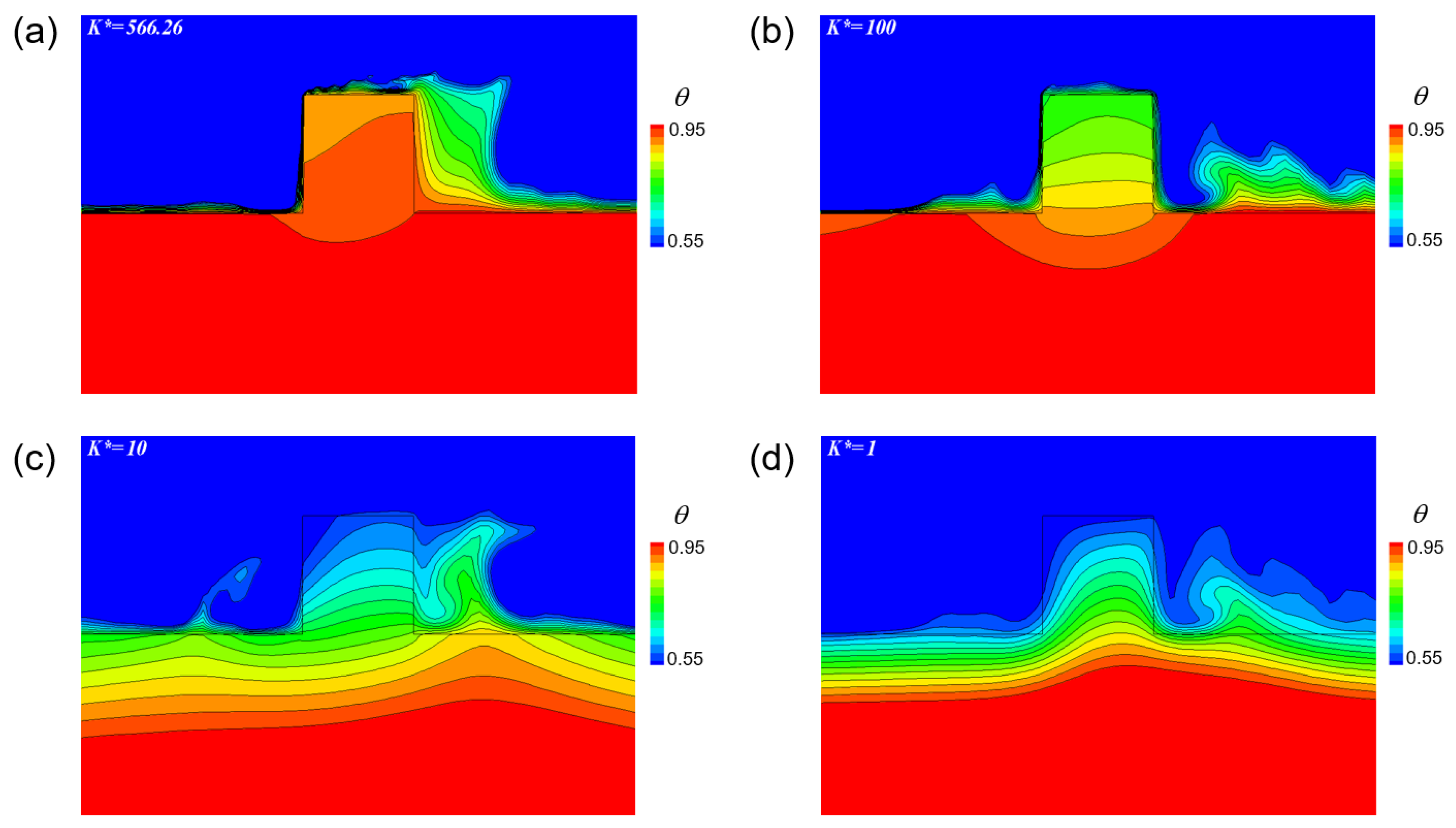
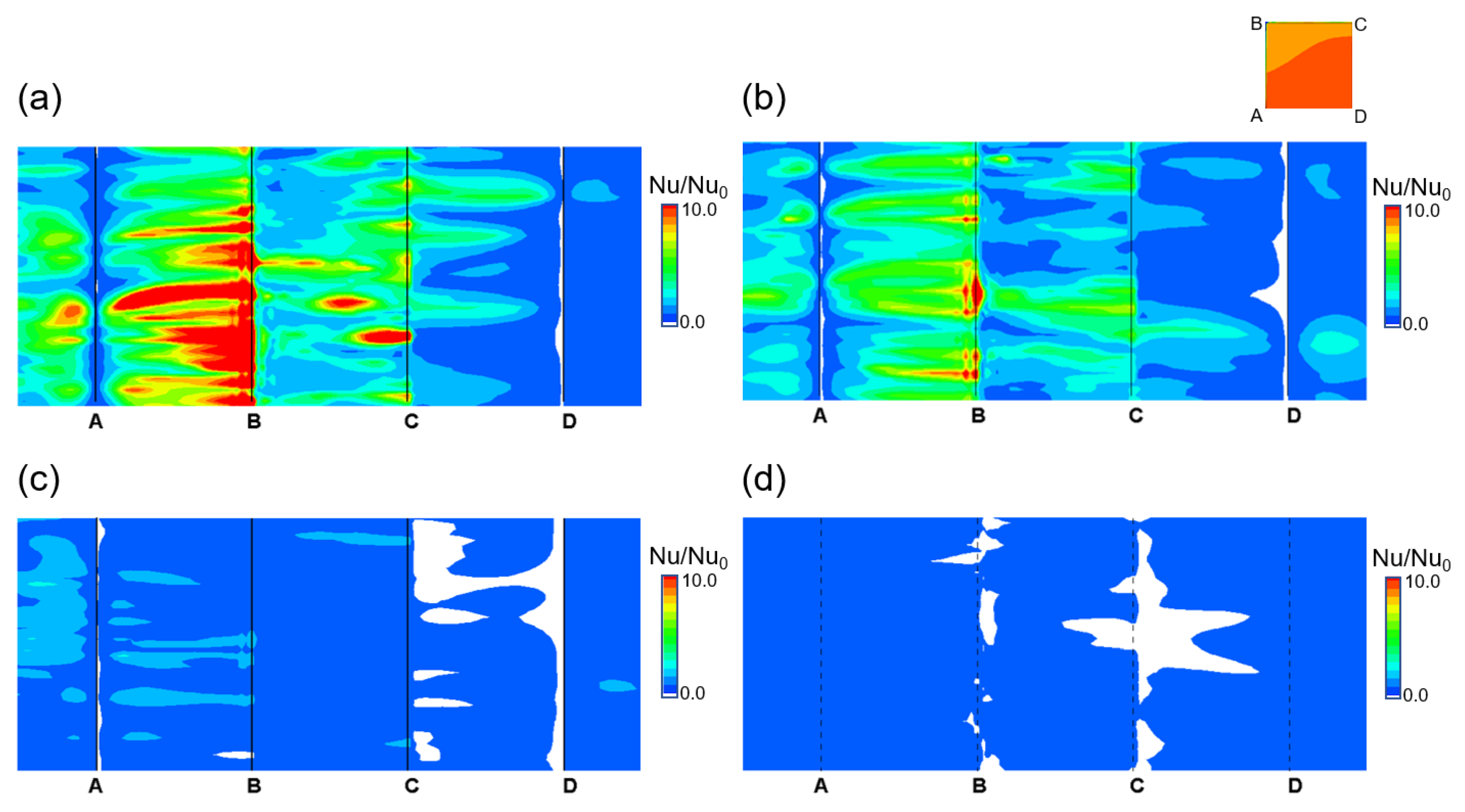
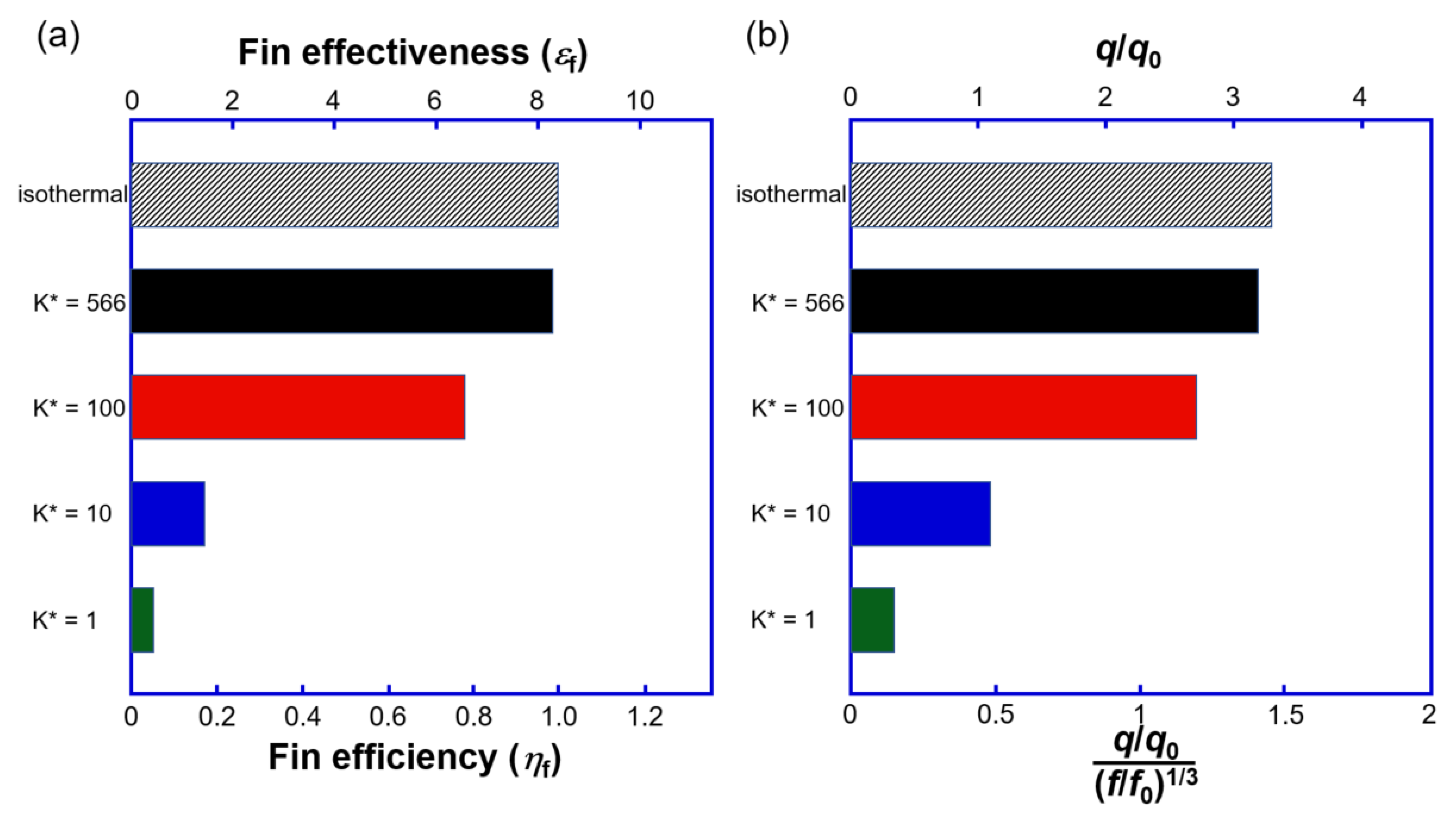
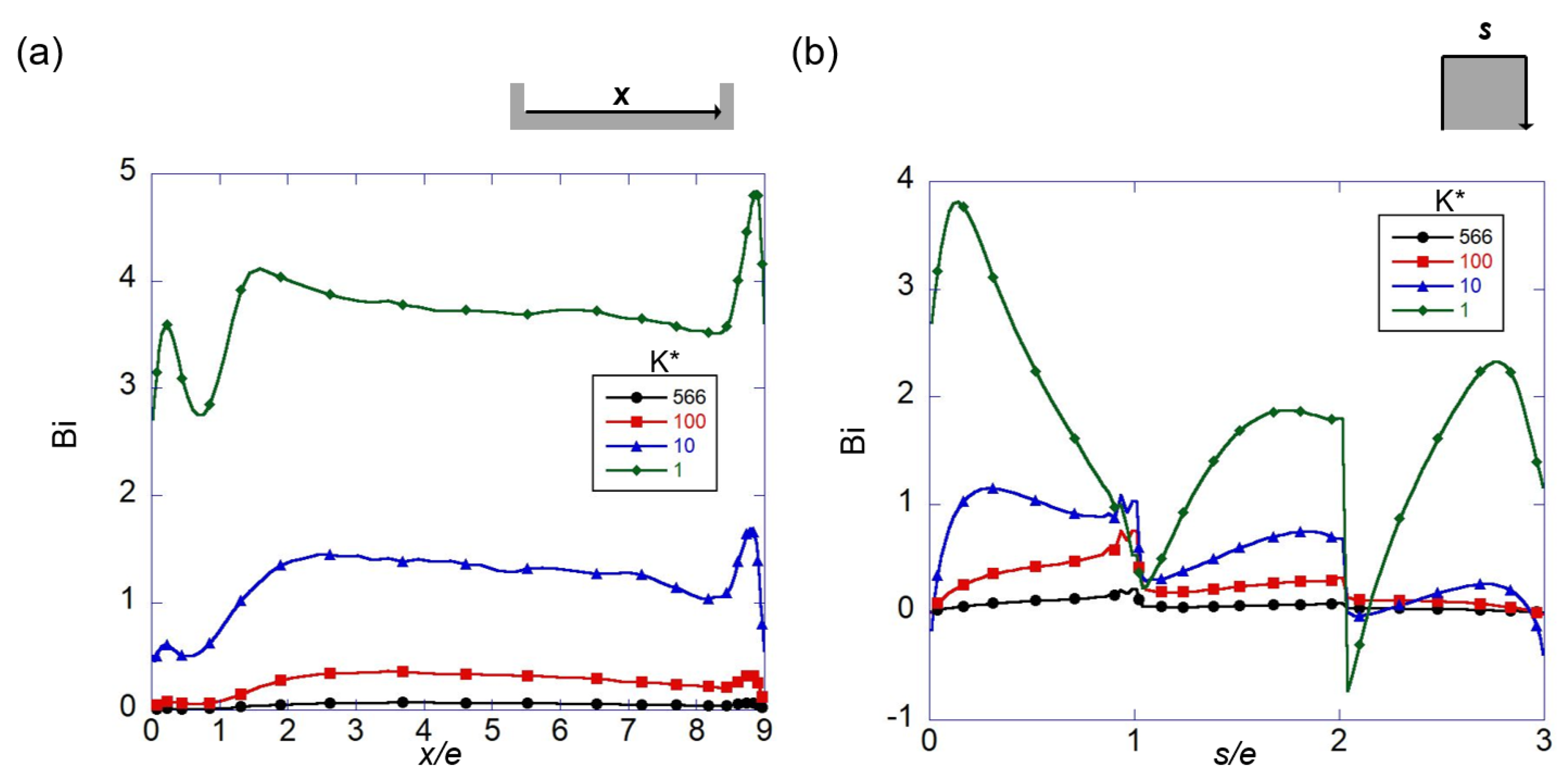
Publisher’s Note: MDPI stays neutral with regard to jurisdictional claims in published maps and institutional affiliations. |
© 2021 by the authors. Licensee MDPI, Basel, Switzerland. This article is an open access article distributed under the terms and conditions of the Creative Commons Attribution (CC BY) license (https://creativecommons.org/licenses/by/4.0/).
Share and Cite
Ahn, J.; Song, J.C.; Lee, J.S. Dependence of Conjugate Heat Transfer in Ribbed Channel on Thermal Conductivity of Channel Wall: An LES Study. Energies 2021, 14, 5698. https://doi.org/10.3390/en14185698
Ahn J, Song JC, Lee JS. Dependence of Conjugate Heat Transfer in Ribbed Channel on Thermal Conductivity of Channel Wall: An LES Study. Energies. 2021; 14(18):5698. https://doi.org/10.3390/en14185698
Chicago/Turabian StyleAhn, Joon, Jeong Chul Song, and Joon Sik Lee. 2021. "Dependence of Conjugate Heat Transfer in Ribbed Channel on Thermal Conductivity of Channel Wall: An LES Study" Energies 14, no. 18: 5698. https://doi.org/10.3390/en14185698
APA StyleAhn, J., Song, J. C., & Lee, J. S. (2021). Dependence of Conjugate Heat Transfer in Ribbed Channel on Thermal Conductivity of Channel Wall: An LES Study. Energies, 14(18), 5698. https://doi.org/10.3390/en14185698







